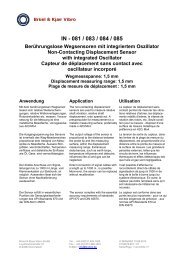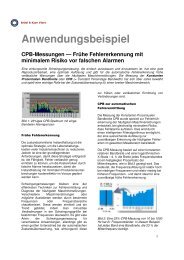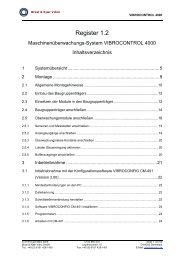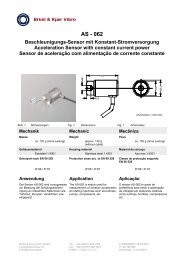Allgemeine Erdungsempfehlung General grounding ...
Allgemeine Erdungsempfehlung General grounding ...
Allgemeine Erdungsempfehlung General grounding ...
You also want an ePaper? Increase the reach of your titles
YUMPU automatically turns print PDFs into web optimized ePapers that Google loves.
Was bewirken<br />
Potentialunterschiede?<br />
Werden zwei Punkte verschiedenen<br />
Potentials miteinander leitend<br />
verbunden, so fliesst ein elektrischer<br />
Strom vom höheren zum niedrigeren<br />
Potential. Die dabei auftretende<br />
Stromstärke hängt von der Höhe des<br />
Potentialunterschieds (Spannung), von<br />
der Leitfähigkeit der Verbindung, und<br />
vom Innenwiderstand der mit den<br />
Punkten verbundenen Einrichtungen<br />
ab.<br />
Man unterscheidet zwischen gewollten<br />
und ungewollten Potentialunterschieden:<br />
• Gewollte Potentialunterschiede,<br />
also nutzbare elektrische Spannungen,<br />
werden von Generatoren<br />
und Batterien zur Bereitstellung<br />
elektrischer Energie erzeugt.<br />
• Die ungewollten Potentialunterschiede,<br />
wie statische Aufladungen<br />
und vor allem die für unsere<br />
Betrachtung relevanten Verschiebungen<br />
von Bezugspotentialen<br />
durch Spannungsfälle in stromdurchflossenen<br />
Rückleitern,<br />
können dagegen zu Störungen<br />
oder sogar zur Zerstörung von<br />
Leitungen und Schaltkreisen<br />
führen.<br />
What influence does<br />
potential difference have?<br />
If two points having a potential<br />
difference are connected together an<br />
electrical current flows from the point<br />
with the higher potential to the point<br />
with the lower potential. The strength<br />
of this resultant current depends on<br />
the magnitude of the potential<br />
difference between the two points<br />
(voltage), the current-carrying capacity<br />
of the connection between them and<br />
the internal resistance of the<br />
equipment connecting the two points.<br />
A differentiation is made between<br />
forced and unforced potential<br />
differences:<br />
• Forced potential differences, such<br />
as usable electrical voltage, is<br />
created by batteries and<br />
generators in the preparation of<br />
electrical energy.<br />
• Unforced potential differences,<br />
such as static electricity and, as<br />
discussed in this article, the<br />
relevant displacement of the<br />
reference potential by voltage<br />
drops in return lines in which<br />
current is flowing, can lead to<br />
interference and also damage to<br />
cables and circuits.<br />
Erdung Grounding Tierra<br />
Qué influencia tiene la<br />
diferencia de potencial?<br />
Si dos puntos con una diferencia de<br />
potencial son conectados entre sí,<br />
fluye una corriente eléctrica desde el<br />
punto con el potencial más alto al<br />
punto con el potencial más bajo. La<br />
fuerza de esta corriente resultante<br />
depende de la magnitud de la<br />
diferencia de potencial entre los dos<br />
puntos (voltaje), la capacidad<br />
conductiva de corriente de la conexión<br />
entre los dos puntos y la resistencia<br />
interna del equipo que conecta estos<br />
dos puntos.<br />
Se diferencia entre diferencias de<br />
potencial forzadas y no forzadas:<br />
• Diferencias de potencial forzadas,<br />
tal como voltaje eléctrico utilizable,<br />
es creado por baterías y generadores<br />
en la preparación de energía<br />
eléctrica.<br />
• Diferencias de potencial no<br />
forzadas, tal como electricidad<br />
estática y, como expuesto en este<br />
artículo, el desplazamiento pertinente<br />
del potencial de referencia<br />
por caídas de voltaje en líneas de<br />
retorno, en las cuales la corriente<br />
fluye, pueden con-ducir a interferencias<br />
y también a daños en<br />
cables y circuitos.<br />
© Erdung DESP 12.4.2006 Seite/Page 25 von/of/de 26
















